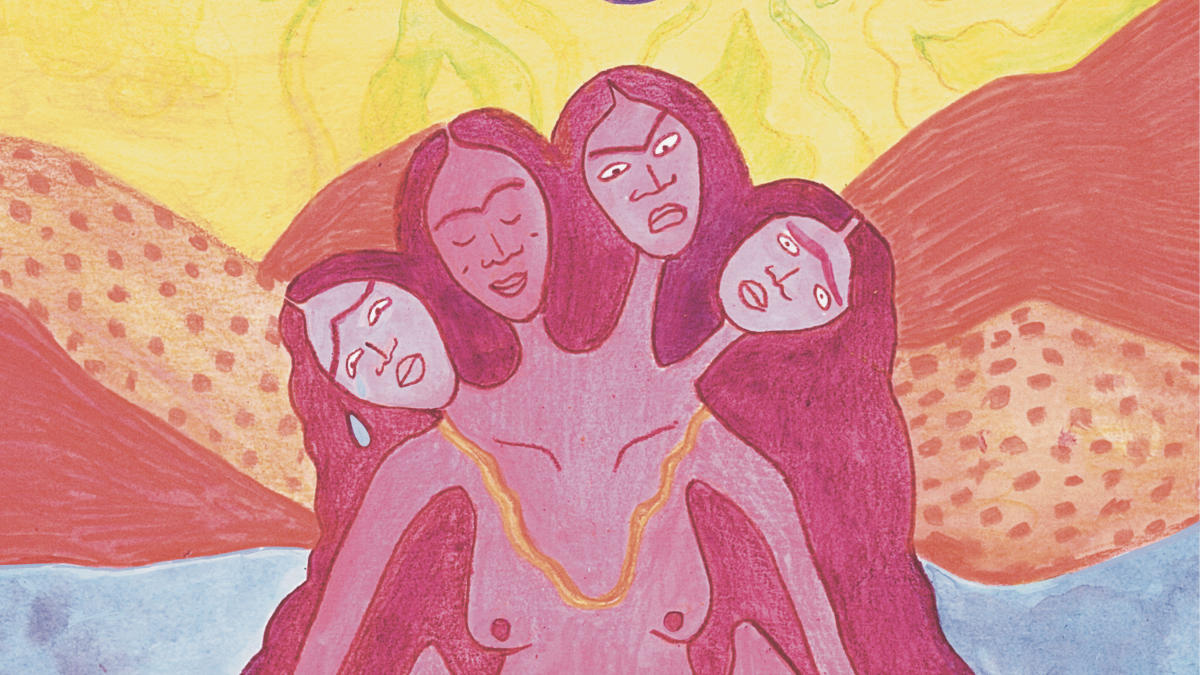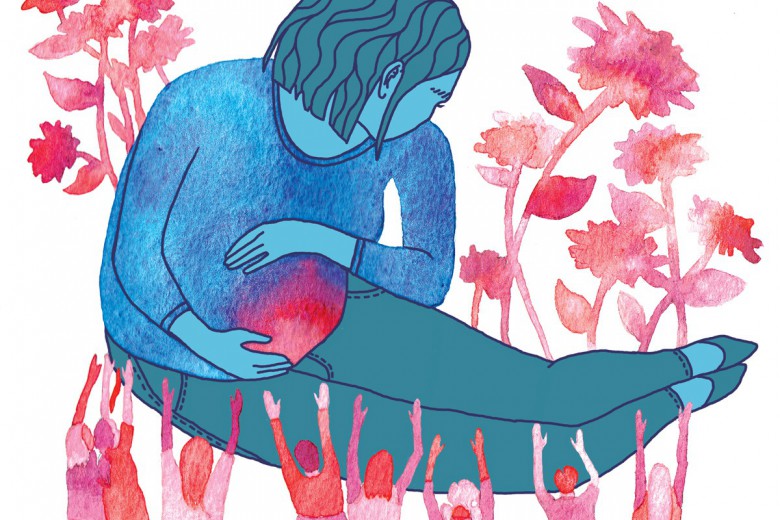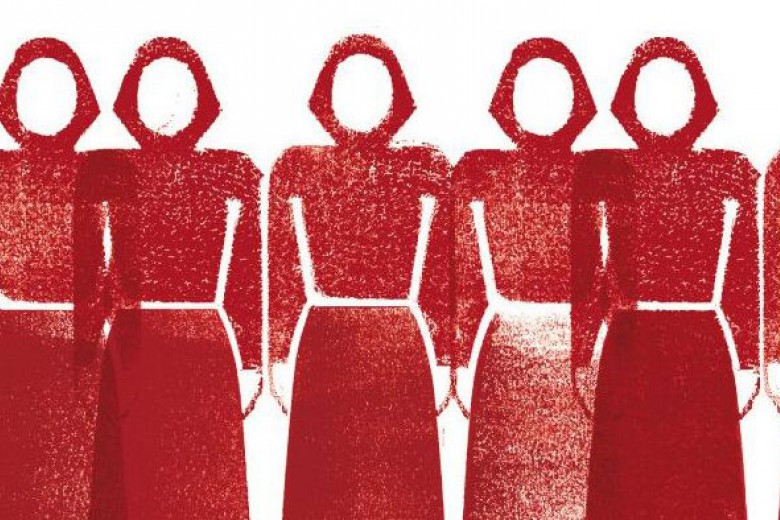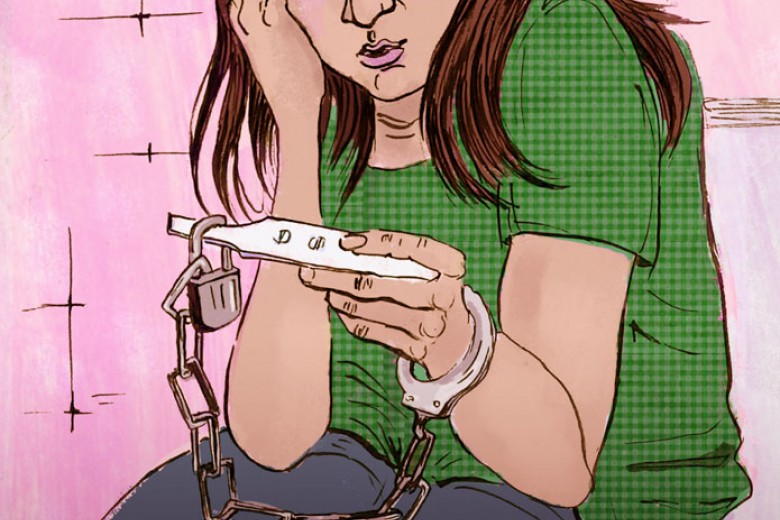I was so excited to start taking the pill in Grade 12. The little sleeve of attractively packaged tablets felt like a membership card – my licence to fuck – and I’d heard they might make my boobs bigger. The first week, I started feeling a little dissociated, and wondered if it could be the pills. Three weeks in, I met with my doctor and told her I’d felt “off” since starting the pill, and she told me to give it three more weeks and see if it improved and prescribed me antidepressants to help. By the next visit, I was experiencing visual and auditory hallucinations (I had never heard voices before, nor have I since) and intrusive thoughts of self-harm. I told my doctor: “I don’t want to kill myself, but when I see a knife I think about plunging it between my ribs and it really scares me.” She again said to give it three more weeks. That evening, in a moment of extreme distress, I googled whether taking 30 Cipralex pills could kill me (the answer is yes), and then I downed the bottle with a mickey of vodka.
From then on, I swore to myself that I would never take any medication that could fuck with my mood. With my own experience in the back of my mind, I listened to my friends’ stories about the side effects they suffered while taking birth control and how doctors downplayed and denied the severity of their symptoms, pressuring them to stay on hormonal contraceptives no matter how unbearable their symptoms became. Many friends didn’t even associate their symptoms with birth control until they stopped taking it and felt a fog lift and colours brighten. One of my friends was put on the pill before ever having sex and was sexually active for about four years before coming off of it and having her first orgasm.
A 2016 study concluded that taking the pill was associated with a subsequent use of antidepressants and a first diagnosis of depression, with teenagers experiencing the highest risk.
I never wanted to tell my friends what they should or shouldn’t do with their bodies, but I cursed the system that was okay with sacrificing our pleasure and risking my life for a purpose that is just as effectively achieved by condoms. I became what I jokingly call a “birth control truther,” meaning I believe that the side effects birth control users experience should be taken seriously and that there must be some larger forces at play to explain why hormonal birth control is so widely prescribed (and to such young people) despite the prevalence of bad experiences.
After years of listening to friends’ experiences with birth control, I began reading research that corroborated what they’d been telling me. A 2016 study published in JAMA Psychiatry concluded that taking the pill was associated with a subsequent use of antidepressants and a first diagnosis of depression, with teenagers experiencing the highest risk. In a 2001 study published in Contraception, 87 per cent of the 79 participants experienced emotional side effects, worsening PMS, and decreased psychosexual arousability while taking the pill. Over half of participants discontinued or switched brands within one year of starting birth control, and the study found that emotional and sexual side effects were the strongest predictors of whether the participant would discontinue or switch brands.
Where is the logic in taking a drug that dampens your sexual pleasure so that you can have more “worry free” sex? I felt indignant, like there was a society-wide psy-op to successfully make it an empowered, feminist move to take a pill that makes you depressed and kills your libido so that guys don’t have to dampen their pleasure by using condoms. I now teach online, pay-what-you-can body literacy workshops where I go over the biology of the menstrual cycle, how hormonal birth control works, and what other options are available. It’s also a place where people can share stories about their cycles and managing their fertility.
We only truly have the “right to choose” if we’re presented with other feasible options.
I don’t think it’s ‘un-feminist’ to use hormonal birth control. I believe in your right to choose what is best for your body and your life – with all of the information in hand. It’s a tricky conversation to have in an era of mounting attacks on reproductive rights. In the U.S., the repeal of Roe v. Wade has meant that effectively managing fertility is increasingly important for people who can give birth. Talking about the dark side of birth control feels dangerous – but it’s an important part of a wider conversation about reproductive justice.
Birth control or population control?
Let’s look at the history of hormonal birth control to understand how we ended up here. The pill became available to women in the U.S. in the 1960s, just as more women began obtaining university degrees, a trend that has since grown. Prior to the 1970s, there were almost no women in careers requiring post-graduate education. But the societal impact of medical birth control extends far beyond its role in helping women elbow their way into the waged workforce. The world-shaping influence of medical birth control runs very deep and very broad – and not all its impacts have been positive.
In 1959, the Draper Committee presented President Eisenhower with a report that would set the course for U.S. foreign policy in the Cold War and beyond. Eisenhower had commissioned the investigation to evaluate the efficacy of the Military Assistance Program, which was acting in foreign countries to fight the spread of communism. The committee proposed that the U.S. continue to militarize “less developed” countries while also providing economic aid to develop their capitalist economies.
In the committee’s opinion, population growth was preventing the economic “advancement” of these countries and diluting the effectiveness of foreign aid spending. Large populations of impoverished people were viewed as fodder for the spread of communism. The committee concluded that administering population control programs would yield the highest return on investment in terms of making foreign aid spending serve U.S. military interests. The committee recommended that Eisenhower found the U.S. Agency of International Development (USAID) to deliver aid funding and oversee such programs.
With the creation of USAID and its directive to fund and oversee population control programs came a proliferation of overseas medical NGOs and international networks of clinics, labs, and other institutions. Through these organizations, bodies in the Global South became available for rich nations to use as research subjects and clinical trial participants (often without their knowledge or consent), and as “aid recipients” of medical products that could not be sold at home because they had painful side effects, were expired, or were banned or recalled.
People in positions of power make choices about who should be trusted with their own fertility and who shouldn’t, whose babies are problems, and whose are blessings.
In other words, the U.S. decision to administer birth control to poor nations sparked the creation of much of the infrastructure for today’s transnational biomedical economy – infrastructure that was then used to sidestep domestic legal and ethical constraints on human drug trials and carry out a vast array of medical experimentation on women overseas to develop the birth control methods that we have today.
In 1989, a diverse international gathering of feminists was held in Comilla, Bangladesh – a hotbed of population control research. There, women from rich countries and poor countries met to discuss the experiments that the latter were being subjected to under varying degrees of duress and understanding. What resulted was the Declaration of Comilla, a document that lays out the risks and harms of new scientific interventions into reproduction, and their inability to solve the issues they claimed to address: poverty, pollution, and the subjugation of women.
In 1798, Thomas Malthus introduced the idea that the number of humans exists in a fixed mathematical relationship with the quantity of resources available. He argued that unchecked population growth would inevitably lead to resource scarcity and mass death into the common imagination – and that idea has rarely left our discourse since. His essay advocates against raising wages or providing social assistance for the poor, rationalizing that if they were not starving, they would marry earlier and have more children and then they would be starving. By 1900, Malthus’ theory was already disproven. The rising standard of living across many parts Europe led birth rates to fall, not the other way around.
In 2019, over a hundred Indigenous women in Canada came forward saying that they had been sterilized by doctors against their will.
Malthus worked hard to make his theory seem objective and logical, but it conveniently obfuscates the true causes of poverty: oppression, exploitation, and wealth hoarding. The terrible conditions that hundreds of millions live in around the world are the result of colonial interference in subsistence lifeways, forced dependence on predatory financial systems, and exploitation within those systems. Poor people are not poor because they are too ignorant to breed less. In fact, in places such as India and China, knowledge of fertility control has existed for centuries. However, this derogatory way of viewing the destitute “masses” of the “developing world” remains deeply ingrained, even on the left.
In 1962 at an international conference sponsored by the Population Council (an NGO founded by John D. Rockefeller III), soon-to-be president of the Planned Parenthood Federation of America Alan Guttmacher spoke of the need for a birth control option suitable for the “masses” of the Global South. “The reason the restraint of population growth in these areas is moving so slowly is the fact that the methods we offer are Western methods, methods poorly suited to [non-Western] culture[s] and to the control of mass population growth,” he stated.
While condoms and pills are suitable for certain types of people, he asserted, others should have their fertility curbed by long-acting reversible contraceptives like intrauterine devices (IUDs) which don’t require ongoing co-operation by the user. In a letter to the chairman of the pharmaceutical company G.D. Searle, Guttmacher commended the devices because “once the damn thing is in, the patient cannot change her mind.” In that same letter, he elaborated on the distinction between birth control for the individual versus the nation: “If [one of our wives] gets pregnant while wearing an IUD, there is quite a stink…. However, if you reduce the birth rate of an unprotected segment of the Korean, Pakistanian [sic], or Indian population… this becomes an accomplishment to celebrate.”
1959 – the year that launched USAID – was the same year that the contraceptive pill was submitted to the U.S. Food and Drug Administration (FDA) for approval after large-scale clinical trials in Puerto Rico. The colony’s poor and racilized population made it a perfect destination to test a new drug in the eyes of the doctors leading the study, Dr. Rock and Dr. Pincus. The medical school conducting the trial pressured students into participating as well, threatening grade penalties if they refused. According to a paper by Dr. Rock and Dr. Pincus, 22 per cent of women dropped out of the trial due to severe side effects including headaches, bloating, and nausea. Dr. Pincus dismissed concerns about the high incidence of side effects, describing them as psychosomatic and blaming the “emotional super-activity of the Puerto Rican woman.” The doctors then conducted additional trials in Puerto Rico, Haiti, and Mexico and appealed the FDA for approval as a contraceptive drug. It was approved by the FDA the next year.
In a 2001 study, 87 per cent of the 79 participants experienced emotional side effects, worsening PMS, and decreased psychosexual arousability while taking the pill.
In the 1970s, there was a wave of public concern about all the harmful side effects of hormonal contraceptives that were coming to light, and U.S. Senator Gaylord Nelson began calling on experts to investigate the health risks of the pill and determine whether more government intervention and oversight was required in the medical industry. In a speech to Planned Parenthood physicians, Dr. James L. Goddard, the commissioner of the FDA between 1966 and 1968, said that adverse reactions to the pill were being “grossly under-reported” and that the lack of adequate data was a “grave issue.” Nevertheless, the sentiment that the pill was an “important weapon in the struggle to achieve some control over our ability to multiply ourselves into chaos,” as expressed by Senator Bob Dole during the 1970 U.S. Congressional hearing, was shared by many.
The calculation that actual present harm to real people is an acceptable price to pay to avoid the hypothetical harm that potential extra people could cause to society has played out time and time again. Killing the Black Body by Dorothy Roberts chronicles the widespread horrors that Black women in the U.S. have endured from programs and policies that have sought to curb their reproduction through coercive use of long-acting reversible contraceptives, which include IUDs, implants, and shots.
For example, in California in the early ’90s, Darlene Johnson was forced by a judge to decide between a four-year prison sentence or only one year in prison if she had the contraceptive Norplant inserted. Norplant consists of six matchstick-size silicone capsules that release a progestin over five years and must be surgically inserted and removed. Although Johnson questioned the safety of the device, the judge pressured her into agreeing, and when she returned the next week to appeal after learning that the device was strongly contraindicated for several of her health conditions, the judge refused to rescind the order.
By not providing us with alternatives, doctors are prioritizing effectiveness over user control and satisfaction, and pregnancy prevention over our autonomy and well-being.
In another case in South Dakota, an Indigenous woman with the Norplant implant requested that her doctor remove it due to intolerable side effects and she was told that it would only be removed if she consented to a tubal ligation. More recently, in 2019, over a hundred Indigenous women in Canada came forward saying that they had been sterilized by doctors against their will. And in 2021, Métis lawyer Breen Ouellette asserted that social workers were forcing Indigenous children in foster care as young as nine to have IUDs inserted by doctors. In at least one case, the reason for the insertion was that the girl was in danger of being raped in her foster home.
Many people reading this might feel like their privilege distances them from the people in these particularly egregious examples. But growing wealth disparities and neoliberal social norms mean that the pool of people who aren’t being pressured to use hormonal birth control – regardless of mental health concerns, diminished sexual pleasure, or increased risk of breast cancer and liver disease (and decreased risk of ovarian and endometrial cancer) – is increasingly small.
The right to choose
People in positions of power make choices about who should be trusted with their own fertility and who shouldn’t, whose babies are problems and whose are blessings. Nowadays, long-acting reversible contraceptives are doctors’ primary birth control recommendation. By not providing us with alternatives, doctors are prioritizing effectiveness over user control and satisfaction, and pregnancy prevention over our autonomy and well-being. We only truly have the “right to choose” if we’re presented with other feasible options.
For some people, fertility awareness-based methods might be a suitable option. Fertility awareness-based methods work by identifying the fertile window and abstaining from sex that could result in pregnancy during that window. A study published in Human Reproduction with 900 participants and a combined total of 17,638 cycles found that after 13 cycles, 98.2 per cent of women avoided pregnancy when they used the symptothermal method of fertility awareness. The pregnancy rate was 0.6 per cent per 13 cycles when participants avoided unprotected sex during the fertile window.
While the ability to prevent unwanted pregnancy is critical to our freedom and autonomy, so is the right to be fertile and cycle without interference from synthetic hormones.
The symptothermal method requires tracking your basal body temperature, which reflects progesterone levels, and characteristics of your cervical fluid, which reflect estrogen levels, daily. An egg disintegrates 12 to 24 hours after ovulation and sperm remain viable for up to five days after sex if enveloped in the right type of cervical fluid. This means that a person’s fertile window is the five days leading up to ovulation, plus the day of ovulation and the day after ovulation, approximately seven days in total. Some sources report fertility awareness-based methods to be around 75 per cent effective, because like hormonal birth control, their effectiveness decreases significantly if they’re not used correctly and consistently.
Joy Davis, of @fullmoon.fertility on Instagram, is an Anishinaabe fertility awareness educator and holistic reproductive health-care practitioner. She teaches the symptothermal method of fertility awareness and her goal is to help people “listen to [their] body and what it is saying every cycle.” The four vital signs – body temperature, pulse rate, respiration rate, and blood pressure – are expressions of the body’s overall health, and menstrual cycles are becoming recognized as a fifth vital sign. The standard course of treatment for medical doctors is to prescribe birth control for any cycle irregularity. The pill shuts down a person’s menstrual cycle, thus alleviating any cycle irregularity, but doesn’t address the root cause of cycle problems like debilitating pain, abnormal bleeding, or hormone-triggered migraines and extreme mood disturbances.
Davis shows her clients how to make evidence-based inferences about their hormone levels and underlying health conditions by routinely charting and analyzing their basal body temperature and cervical fluid in conjunction with when and how their specific recurring symptoms (which could include anything from insomnia to yeast overgrowth) show up. This type of analysis can often reveal patterns that point to things like hyper- or hypothyroidism, polycystic ovarian syndrome, or auto-immune conditions. Holistic reproductive health-care practitioners like Davis are trained to help identify and shift lifestyle factors, such as diet, sleep, and movement habits, that could make a big difference in one’s health journey.
We must fight for the right to be fertile and cycle without interference from synthetic hormones.
Davis came to fertility awareness after trying hormonal contraceptives. Her side effects included brain fog, mood swings, extreme exhaustion, chronic urinary tract infections, and no sex drive. But once she stopped taking birth control, she says “almost immediately all of the effects I was dealing with went away. I felt like a veil was lifted from my life and I could feel emotions deeper, my mind was clearer, and I was so much happier.” Learning fertility awareness improved her life greatly, not only because she was able to avoid the side effects of hormonal contraceptives, but because she gained a greater understanding of and appreciation for her body. By paying attention to the signs it was giving her, she was able to give her body the rest and nourishment it needed to avoid debilitating periods, and she was able to adjust her life to accommodate the fluctuations in mood, energy, and cognitive processing that occur during a healthy cycle.
Demanding reproductive justice
When the pill was first introduced, it was considered a huge win for feminism because it allowed us to prevent pregnancy without co-operation from the men who get us pregnant. While the ability to prevent unwanted pregnancy is critical to our freedom and autonomy, hormonal contraceptives are not the only way. We must also fight for the right to be fertile and cycle without interference from synthetic hormones.
Fertility awareness has a Catholic cousin, natural family planning, which anti-feminist, anti-choice advocates argue should replace all other contraceptives and abortion. I fear that the association between these methods and our ideological opponents will cause feminist health advocates to avoid having nuanced conversations about the dark side of hormonal birth control – its health impacts, the ways it is weaponized against marginalized communities, and its role in 21st century imperialism and eugenics.
But healthy left-wing suspicion about hormonal birth control isn’t the same as anti-feminist, right-wing propaganda. For many years, hormonal birth control has been held up as a sacred symbol of “choice.” If “choice” is the clarion call of the reproductive justice movement, then the movement must demand that hormonal contraceptive users be fully informed about its side effects and consent to using it on an ongoing basis, and that it be one choice among many fertility management options presented to people who can give birth.







